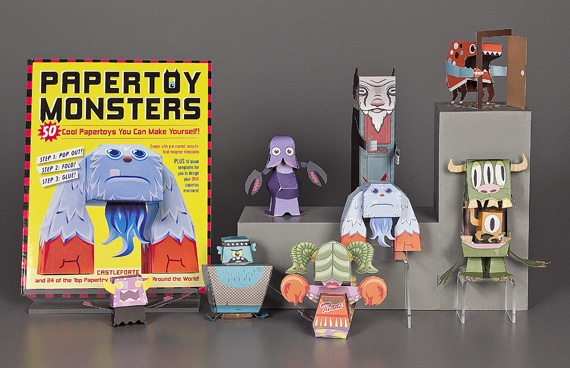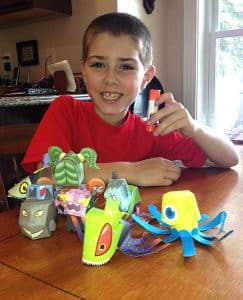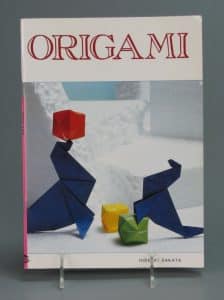What comes to mind when you hear the term “paper toys”? Whatever you envision, chances are the idea of paper toys in our digital era doesn’t evoke quite the same level of enthusiasm as some other playthings do. Paper toys seem quiet and simple, perhaps even old-fashioned. But paper toys such as paper dolls, which first appeared in France and England in the 18th century, have proven themselves enduring playthings for centuries. And a recent visit with a young cousin made me realize just how entertaining and relevant paper toys remain.

 My cousin Dylan is a 9-year-old boy who loves sports, reading, LEGO, outdoor play, and electronic games. In short, he’s an extremely bright, busy kid. One of the things he was most excited to share with me was a new book called Papertoy Monsters. The book contains pages of illustrated monsters, printed on heavy cardstock and perforated along the edges, with detailed, numbered instructions. With the help of a glue stick, the monsters are easily assembled (with exception of Rockmon—a challenge for even the most skilled monster-maker!), transforming from single-page drawings into colorful 3-D friends. The monsters Dylan and I assembled over the course of the weekend definitely brightened up my coffee table (until they went home with him to New Hampshire).
My cousin Dylan is a 9-year-old boy who loves sports, reading, LEGO, outdoor play, and electronic games. In short, he’s an extremely bright, busy kid. One of the things he was most excited to share with me was a new book called Papertoy Monsters. The book contains pages of illustrated monsters, printed on heavy cardstock and perforated along the edges, with detailed, numbered instructions. With the help of a glue stick, the monsters are easily assembled (with exception of Rockmon—a challenge for even the most skilled monster-maker!), transforming from single-page drawings into colorful 3-D friends. The monsters Dylan and I assembled over the course of the weekend definitely brightened up my coffee table (until they went home with him to New Hampshire).
 Indeed, my interaction with this book proved to have a “monstrous” impact, as it made me consider many other types of paper toys and entertainment, including the art of origami. When I was in high school, my family hosted Tomomi, a Japanese exchange student. During Tomomi’s first day in our home, it became apparent that the language barrier was a bit more challenging than anyone had anticipated. With my parents at work all day, it was up to me to ensure our guest felt welcome and comfortable. Eventually, Tomomi and I found ourselves seated at the kitchen table where she shared her knowledge of origami with me, demonstrating how to fold brightly colored paper into beautiful cranes, flowers, and other forms. We communicated easily, although neither of us really spoke. Who would have thought that paper—such a simple thing!—could be such an effective tool for communication?
Indeed, my interaction with this book proved to have a “monstrous” impact, as it made me consider many other types of paper toys and entertainment, including the art of origami. When I was in high school, my family hosted Tomomi, a Japanese exchange student. During Tomomi’s first day in our home, it became apparent that the language barrier was a bit more challenging than anyone had anticipated. With my parents at work all day, it was up to me to ensure our guest felt welcome and comfortable. Eventually, Tomomi and I found ourselves seated at the kitchen table where she shared her knowledge of origami with me, demonstrating how to fold brightly colored paper into beautiful cranes, flowers, and other forms. We communicated easily, although neither of us really spoke. Who would have thought that paper—such a simple thing!—could be such an effective tool for communication?
If you find yourself in need of entertainment, but are short on funds, there are plenty of paper toys and games you can create yourself. As a child, my friends and I loved to make paper fortune telling toys, sometimes out of colorful construction paper, other times out of simple lined notebook paper. We covered them with handwritten numbers, notes, and doodles. I’ve also heard that paper football remains popular among students, although I never quite had the knack for it. However, I have crafted paper chains—an entertaining activity that provides festive décor for any home, classroom, or holiday tree. And countless variations of paper airplanes can turn any room into a hangar and will likely have kids researching aerodynamic folding techniques.
No matter how much technology may evolve, some of the most enjoyable forms of play remain quite simple. That may be worth jotting down somewhere—just be sure it’s not on your favorite paper airplane, crane, or monster.
 Hours 10 a.m.–5 p.m. | Fri. & Sat. till 8 p.m.
Hours 10 a.m.–5 p.m. | Fri. & Sat. till 8 p.m.